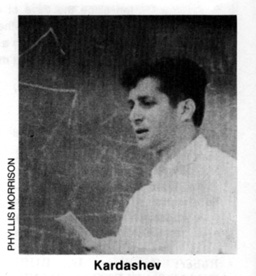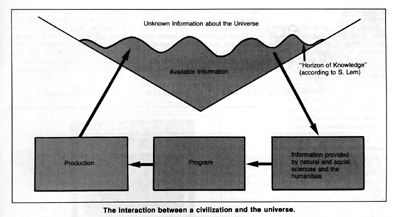|
Strategies of Searching for Extraterrestrial Intelligence
A Fundamental Approach to the Basic Problem
By: Nikolai S. Kardashev
 Detection and studies of extraterrestrial civilizations constitute a problem of immense significance for the progress of humanity and for its culture and philosophy. The discovery of intelligent life in the Universe would provide a guideline to the possible development of our civilization over astronomical time spans. Such information could radically change the entire pattern of our life and activity. Interest in this problem is growing from year to year, involving more and more experts in
various natural sciences.
Detection and studies of extraterrestrial civilizations constitute a problem of immense significance for the progress of humanity and for its culture and philosophy. The discovery of intelligent life in the Universe would provide a guideline to the possible development of our civilization over astronomical time spans. Such information could radically change the entire pattern of our life and activity. Interest in this problem is growing from year to year, involving more and more experts in
various natural sciences.
Whom Can We Find?
Proceeding from a basic, reliable observation of astrophysics, that there are fundamental laws which are valid in any observed space and at any period in the evolution of the Universe, we have every reason to believe that all the typical features which we know in the Universe are also known and used by other civilizations. Our civilization is of course still too young to establish contact with others. Since the Solar System belongs to the second stellar generation in the Galaxy and its age is about 5 billion years while the age of the oldest objects in the Universe may be 10 to 20 billion years, it is clear that the lifetime of other civilizations (and in particular, their communicative age) can be incomparably longer than ours. Hence, their knowledge can be much richer than ours, and they must certainly know what we are doing.
Furthermore, because the forms of objects and the idiosyncracies of their evolution are common throughout the observable Universe, it is quite probable that our present state is one through which any civilization should pass during its initial evolution. It may therefore be possible to define civilization on the basis of its universal character as in the functional definition of life on Earth given by A.A. Liapunov as "a highly stable state of matter, which uses information encoded by the states of individual molecules to produce maintaining reactions."
It is highly likely that life becomes possible when a specific type of molecule can be synthesized which is capable of storing and employing the simplest kind of information about the environment and its own structure. This information can later be used to assure survival, reproduction and what is most essential for us, to acquire further information. The regularity is brought about by physical and chemical forces, partially inherent in the molecules, partially dependent on the ambient conditions. In terms of biology, lower forms of life realize this regularity through mutations and natural selection. This same regularity might be regarded as the main stimulus to the evolution of higher forms of civilization.
The way in which higher life forms differ essentially from others is in their capability to abstractly analyze the information acquired. At further stages of the evolution of life, systems of living organisms also come into being, subject to the same kind of regularity. Following the definition of life, given above, I suggest the following functional definition of a civilization at the highest level.
Civilization is a highly stable state of matter capable of acquiring, making abstract analysis of, and utilizing information to obtain qualitatively new information about its environment and about itself, to improve its capabilities of gathering new information for producing sustaining reactions. Civilization is characterized by the content of the information acquired, by the program of functioning, and by the production required to implement these functions.
To specify the method of information coding in this particular case is, in our opinion, quite meaningless since it must account for books, image recording methods, computer memories and possibly artifical life forms which might become available in the future. "Information about the environment and about itself" means data about inorganic and organic nature (including civilizations), science, technology, economy, culture, the arts, etc.

The accompanying figure illustrates the definition given above. It shows the interaction between a civilization and the Universe to which it belongs. To fulfill its desired objectives, the civilization makes use of production and the total sum of acquired learning (which consists of information provided by the natural and social sciences and by the humanities), as well as the program which analyzes that information and produces commands to control the production. This definition of civilization implies that its activity is a means of implementing the functions mentioned in the definition, rather than activity for its own sake.
Another essential question is the concept of a structural and hierarchical character of the information about nature and society. This concept is often presented as an information tree of which only some branches are known to us at present. That is why our definition of civilization emphasizes that evolution requires a continuous flow of qualitatively new information: either higher-order information generalizing well-known laws, or the discovery of new and unfamiliar branches of the information tree. How then, is the longevity of civilizations related to a finite or infinite number of still unknown, fundamental laws of nature?
If all the basic laws are soon discovered, our future will consist only of quantitative evolution. One possible outcome is the extinction of mankind through boredom, degeneration, and loss of interest. However, we do not face such a problem, at least at present. There is an enormous number of basic problems in both the natural and social sciences, which are very far from being solved. The process for their solution will probably generate even more novel and fundamental problems in turn. Here are some examples of outstanding problems in the natural sciences:
- A unified theory of gravitation and relativistic quantum mechanics;
- A theory of elementary particles;
- A theory explaining the numerical values of fundamental physical contants: velocity of light, Planck's constant, constant of gravity, the charge and mass of electrons and protons (or the values of their dimensional combinations);
- The problem of a finite or infinite number of fundamental laws for the microcosm;
- A theory explaining what existed before and at the beginning of the expansion of the Universe, which we are now witnessing;
- A theory explaining the numerical values of the expansion velocity and acceleration of the Universe, as well as its mean density and entropy;
- A theory describing what goes on inside a black hole as seen by an observer falling into it;
- The question of whether cosmic space is simply connected? If not, are there any other worlds, other than the observable micro- and macro-cosms?
- The question of whether the number of fundamental laws of the macrocosm is finite;
- A theory of the origin of life on Earth and the different forms of the origin of life in other parts of the Universe;
- A theory of the brain activity of man and animals.
Thus there is a great variety of important problems whose solution cannot be predicted. We, therefore, draw several conclusions:
First, there is a broad and probably unlimited range of activities required by civilizations for solving problems similar to those mentioned above. Therefore, the period of the evolution and communicative phase of civilizations is long, or possibly even unlimited.
Second, our current level covers only a negligible fraction of that phase. It is therefore highly unlikely that we shall ever meet "brothers in intelligence" who are at our stage of evolution.
Third, highly advanced civilizations know and make wide use of natural laws of which we are still unaware. In my opinion, the latter point should also be taken into account in planning searches for extraterrestrial civilizations.
It is quite probable that our present state is one through which any civilization should pass during its initial evolution.
It is furthermore worthwhile to analyze several hypothetical models of the evolution of civilization:
1. In the paper, "Possibility of the Intelligent Life in the Universe Being Unique," I.S. Shklovsky* (* Astronomy, 5, N1 (1977) ) writes that it is strange that the "blast wave of intelligence" of a supercivilization has not engulfed the whole Universe. If all the above considerations are taken into account, the argument against such a possibility is that it is not so very necessary to expand the occupied space to maintain the activity of the civilization. First, why expand, if everything is the same all over the Universe? Second, in terms of the rate at which the parts of the system exchange information, it is not feasible for them to expand in size. On the contrary, it is more advantageous for two widely separated civilizations to merge, thereby enhancing the information content of each individual civilization while reducing the number of civilizations and the space they occupy.
2. Instead of unrestricted expansion through space, it is possible that the civilizations pursue the following activities, with the aim of acquiring information about new fundamental laws:
- Studies of the microcosm;
- Purpose-oriented space flights to the most interesting objects in our Universe (what about a flight to the center of the Galaxy as a long-term objective?);
- Studies of possible transitions into spaces with dimensions different from ours (through a charged black hole, for example).
High energy is undoubtedly required for such activities of civilizations, and we might expect that the efficiency of its consumption would be sufficiently high. Then according to thermodynamics, the energy consumed will be mainly transformed into radiation with a bolometric intensity approximately equal to that of the background radiation around the source. The spectral distribution of the intensity would be close to that of a black body. This offers one of the possibilities of searching for civilizations. A second premise which could be checked observationally is that large quantities of solid material would be used by a civilization for its astro-engineering activity. The final assumption is that information is sent in the form of electromagnetic radiation.
(To be continued)
|
![[NAAPO Logo]](../../Images/NAAPOsm.jpg)
![[NAAPO Logo]](../../Images/NAAPOsm.jpg)